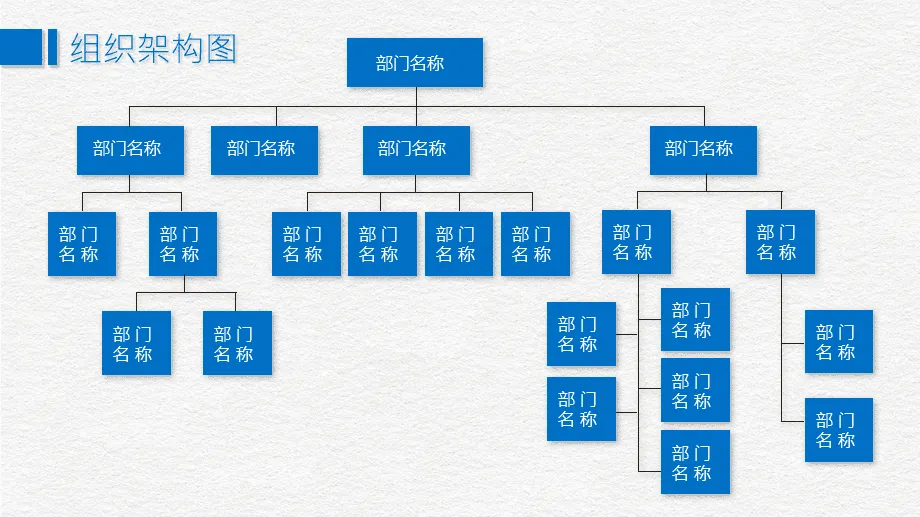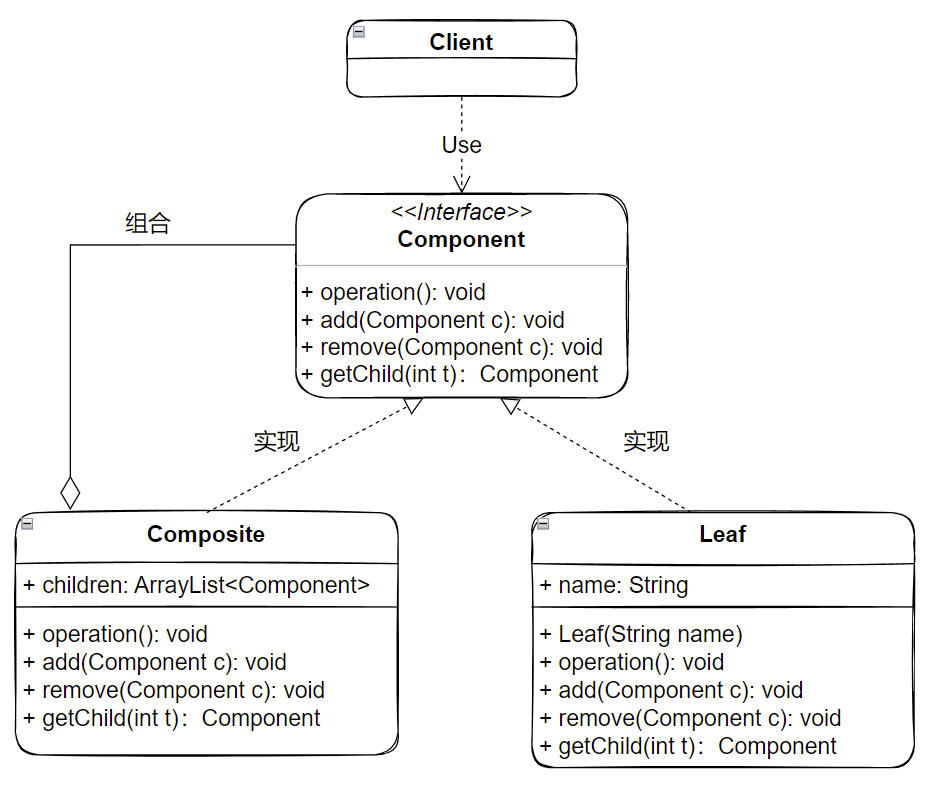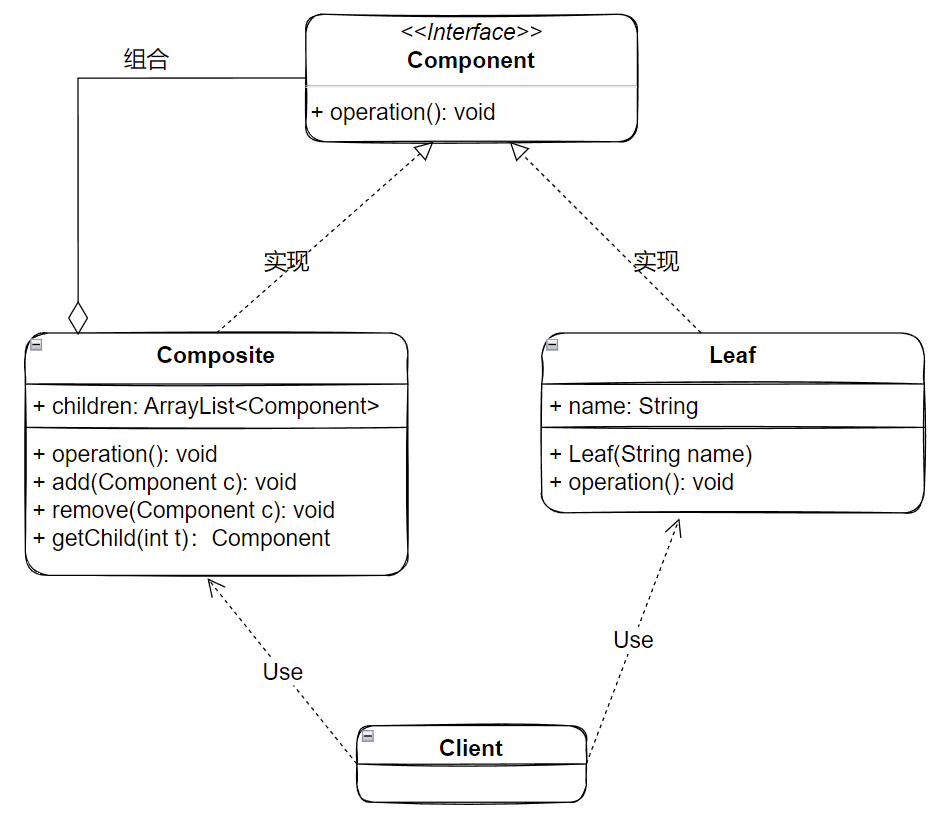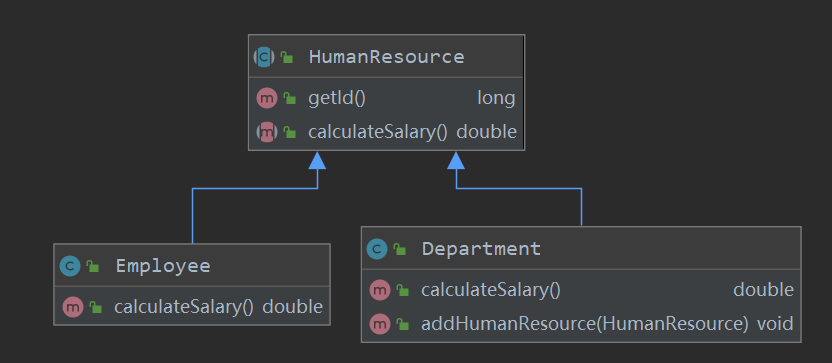Python微信订餐小程序课程视频
https://edu.csdn.net/course/detail/36074
Python实战量化交易理财系统
https://edu.csdn.net/course/detail/35475
组合(Composite)模式,又叫做树形模式,主要用来处理树形结构数据。是将一组对象组织成树形结构,以表示一种“部分-整体”的层次结构。让客户端可以统一单个对象和组合对象的处理逻辑。
一、组合模式介绍
组合模式通过以树形结构来表示“部分-整体”,使得用户对叶对象和组合对象的使用具有一致性。也就是说在组合模式中,整个树形结构的对象都属于同一种类型,用户可以对叶对象和组合对象统一处理。
1.1 组合模式分类
组合模式主要有透明式和安全式两种分类,下面来分别说明
1.1.1 透明式组合模式
在该方式中,抽象构件声明了所有子类中的全部方法,这样实现抽象构件接口的所有子类都具备了全部方法,这样的好处是叶节点和枝节点对于外界没有任何区别,它们具备了完全一致的接口。但是对于叶节点有些本身不具备的方法,就可能会有安全隐患(空指针异常等)。其结构类图如下所示:
Component:抽象构件,为叶节点和树枝节点声明公共接口,以及访问和管理子类的接口Composite:树枝构件,组合中的分支节点对象,作用是存储和管理子部件Leaf:树叶构件,组合中的叶节点对象,用于继承和实现抽象构件Client:客户端
1.1.2 安全式组合模式
前面提到透明式组合模式中,因为抽象构件声明所有子类方法,有可能会造成安全问题。所以在安全式中,将管理叶节点的方法转移到树枝构件中,抽象构件和树叶构件没有对子对象的管理方法,这样就避免了透明式组合模式中的安全问题。但是由于树叶和树枝构件有不同的接口,因此在使用时,就不能将两种构件一概而论,对于客户端调用方而言,就失去了透明性。其结构类图如下所示:
Component:抽象构件,为叶节点和树枝节点声明公共接口,没有访问和管理子类的接口Composite:树枝构件,组合中的分支节点对象,作用是存储和管理子部件Leaf:树叶构件,组合中的叶节点对象,没有对子类的管理方法Client:客户端
1.2 组合模式实现
根据上面的类图,可以实现如下代码:
1.2.1 透明式组合模式实现
/**
* @description: 透明式抽象构件
* @author: wjw
* @date: 2022/4/3
*/
public interface Component {
/**公共操作方法**/
void operation();
/**
* 添加构件
* @param c 组合模式中的构件
*/
void add(Component c);
/**
* 移除构件
* @param c 组合模式中的构件
*/
void remove(Component c);
/**
* 获得子对象
* @param t 子对象序号
* @return 子对象
*/
Component getChild(int t);
}
/**
* @description: 树枝节点
* @author: wjw
* @date: 2022/4/3
*/
public class Composite implements Component{
private ArrayList children = new ArrayList<>();
@Override
public void operation() {
for (Component child : children) {
child.operation();
}
}
@Override
public void add(Component c) {
children.add(c);
}
@Override
public void remove(Component c) {
children.remove(c);
}
@Override
public Component getChild(int t) {
return children.get(t);
}
}
/**
* @description: 树叶节点
* @author: wjw
* @date: 2022/4/3
*/
public class Leaf implements Component{
private String name;
public Leaf(String name) {
this.name = name;
}
@Override
public void operation() {
System.out.println("我是树叶节点:" + name);
}
@Override
public void add(Component c) {
}
@Override
public void remove(Component c) {
}
@Override
public Component getChild(int t) {
return null;
}
}
/**
* @description: 客户端类
* @author: wjw
* @date: 2022/4/3
*/
public class Client {
public static void main(String[] args) {
Component component = new Composite();
Component leaf1 = new Leaf("1");
Component leaf2 = new Leaf("2");
component.add(leaf1);
component.add(leaf2);
component.operation();
component.getChild(1).operation();
//这里树叶构件能调用add方法就会造成安全隐患
leaf1.add(leaf1);
}
}
客户端运行结果:
我是树叶节点:1
我是树叶节点:2
我是树叶节点:2
1.2.2 安全式组合模式实现
/**
* @description: 安全式抽象构件
* @author: wjw
* @date: 2022/4/3
*/
public interface Component {
/**公共操作方法**/
void operation();
}
/**
* @description: 树枝节点
* @author: wjw
* @date: 2022/4/3
*/
public class Composite implements Component{
private ArrayList children = new ArrayList<>();
@Override
public void operation() {
for (Component child : children) {
child.operation();
}
}
public void add(Component c) {
children.add(c);
}
public void remove(Component c) {
children.remove(c);
}
public Component getChild(int t) {
return children.get(t);
}
}
/**
* @description: 树叶节点
* @author: wjw
* @date: 2022/4/3
*/
public class Leaf implements Component{
private String name;
public Leaf(String name) {
this.name = name;
}
@Override
public void operation() {
System.out.println("我是树叶节点:" + name);
}
}
/**
* @description: 客户端类
* @author: wjw
* @date: 2022/4/3
*/
public class Client {
public static void main(String[] args) {
Composite composite = new Composite();
Leaf leaf1 = new Leaf("1");
Leaf leaf2 = new Leaf("2");
composite.add(leaf1);
composite.add(leaf2);
composite.operation();
}
}
客户端测试结果:
我是树叶节点:1
我是树叶节点:2
二、组合模式应用场景
组合模式常见的应用场景主要是出现树形结构的地方,比如文件目录,公司人员架构图等等
2.1 公司人员架构
比如按照部门和员工组织成树形结构,可以统一处理薪资:
/**
* @description: 人力资源抽象构件
* @author: wjw
* @date: 2022/4/3
*/
public abstract class HumanResource {
protected long id;
protected double salary;
public HumanResource(long id) {
this.id = id;
}
public long getId() {
return id;
}
/**
* 计算工资
* @return 工资结果
*/
public abstract double calculateSalary();
}
/**
* @description: 部门树枝构件
* @author: wjw
* @date: 2022/4/3
*/
public class Department extends HumanResource{
private List humanResources = new ArrayList<>();
public Department(long id) {
super(id);
}
@Override
public double calculateSalary() {
double totalSalary = 0;
for (HumanResource humanResource : humanResources) {
totalSalary += humanResource.calculateSalary();
}
this.salary = totalSalary;
return totalSalary;
}
public void addHumanResource(HumanResource humanResource) {
humanResources.add(humanResource);
}
}
/**
* @description: 员工树叶构件
* @author: wjw
* @date: 2022/4/3
*/
public class Employee extends HumanResource{
public Employee(long id, double salary) {
super(id);
this.salary = salary;
}
@Override
public double calculateSalary() {
return salary;
}
}
参考资料
《设计模式之美》
http://c.biancheng.net/view/1373.html
《Java 设计模式》
《设计模式:可复用面向对象软件的基础》
转载请注明:xuhss » 设计模式学习笔记(十三)组合模式及其在树形结构中的应用



